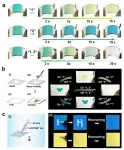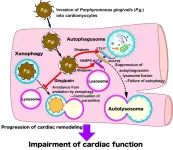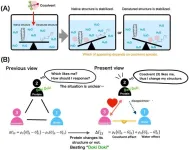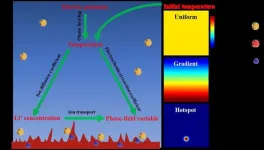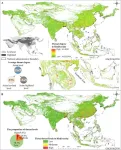(Press-News.org) A breakthrough development in photonic-electronic hardware could significantly boost processing power for AI and machine learning applications.
The approach uses multiple radio frequencies to encode data, enabling multiple calculations to be carried out in parallel.
The method shows promise for outperforming state-of-the-art electronic processors, with further enhancements possible.
In a paper published today in Nature Photonics, researchers from the University of Oxford, along with collaborators from the Universities of Muenster, Heidelberg, and Exeter, report on their development of integrated photonic-electronic hardware capable of processing three-dimensional (3D) data, substantially boosting data processing parallelism for AI tasks.
Conventional computer chip processing efficiency doubles every 18 months, but the processing power required by modern AI tasks is currently doubling around every 3.5 months. This means that new computing paradigms are urgently needed to cope with the rising demand.
One approach is to use light instead of electronics – this allows multiple calculations to be carried out in parallel using different wavelengths to represent different sets of data. Indeed, in ground breaking work published in the journal Nature in 2021, many of the same authors demonstrated a form of integrated photonic processing chip that could carry out matrix vector multiplication (a crucial task for AI and machine learning applications) at speeds far outpacing the fastest electronic approaches. This work resulted in the birth of the photonic AI company, Salience Labs, a spin-out from the University of Oxford.
Now the team has gone further by adding an extra parallel dimension to the processing capability of their photonic matrix-vector multiplier chips. This “higher-dimensional” processing is enabled by exploiting multiple different radio frequencies to encode the data, propelling parallelism to a level far beyond that previously achieved.
As a test case the team applied their novel hardware to the task of assessing the risk of sudden death from electrocardiograms of heart disease patients. They were able to successfully analyse 100 electrocardiogram signals simultaneously, identifying the risk of sudden death with a 93.5% accuracy.
The researchers further estimated that even with a moderate scaling of 6 inputs × 6 outputs, this approach can outperform state-of-the-art electronic processors, potentially providing a 100-times enhancement in energy efficiency and compute density. The team anticipates further enhancement in computing parallelism in the future, by exploiting more degrees of freedom of light, such as polarization and mode multiplexing.
First author Dr Bowei Dong at the Department of Materials, University of Oxford said: ‘We previously assumed that using light instead of electronics could increase parallelism only by the use of different wavelengths – but then we realised that using radio frequencies to represent data opens up yet another dimension, enabling superfast parallel processing for emerging AI hardware.’
Professor Harish Bhaskaran, Department of Materials, University of Oxford and CO-founder of Salience Labs, who led the work said: ‘This is an exciting time to be doing research in AI hardware at the fundamental scale, and this work is one example of how what we assumed was a limit can be further surpassed.’
Notes to editors:
For media inquiries, and requests for interviews and images, contact:
Professor Harish Bhaskaran: harish.bhaskaran@materials.ox.ac.uk
Dr Bowei Dong: bowei.dong@materials.ox.ac.uk
Images and a video that can be used to illustrate articles can be found in this folder: https://www.dropbox.com/scl/fo/m75330lte6qh3y9ik9gu0/h?rlkey=viuzqyym4au8rgikra2kgqob8&dl=0 The caption for the images is ‘Artistic rendering of a photonic chip with both light and RF frequency encoding data. Credit: B.Dong/ University of Oxford.’
The study ‘Higher-dimensional processing using a photonic tensor core with continuous-time data’ will be published in Nature Photonics at 16:00 BST/ 11:00 ET Thursday 19 October 2023 at https://www.nature.com/articles/s41566-023-01313-x. To view a copy of the manuscript under embargo, see: https://www.dropbox.com/scl/fo/m75330lte6qh3y9ik9gu0/h?rlkey=viuzqyym4au8rgikra2kgqob8&dl=0
The work was supported by the EU Horizon 2020 PHOENICS project (Grant No. 101017237) and the EU Innovation Council Pathfinder project HYBRAIN (Grant No. 101046878).
About the University of Oxford
Oxford University has been placed number 1 in the Times Higher Education World University Rankings for the eighth year running, and number 3 in the QS World Rankings 2024. At the heart of this success are the twin-pillars of our ground-breaking research and innovation and our distinctive educational offer.
Oxford is world-famous for research and teaching excellence and home to some of the most talented people from across the globe. Our work helps the lives of millions, solving real-world problems through a huge network of partnerships and collaborations. The breadth and interdisciplinary nature of our research alongside our personalised approach to teaching sparks imaginative and inventive insights and solutions.
Through its research commercialisation arm, Oxford University Innovation, Oxford is the highest university patent filer in the UK and is ranked first in the UK for university spinouts, having created more than 300 new companies since 1988. Over a third of these companies have been created in the past five years. The university is a catalyst for prosperity in Oxfordshire and the United Kingdom, contributing £15.7 billion to the UK economy in 2018/19, and supports more than 28,000 full time jobs.
END
From square to cube: Hardware processing for AI goes 3D, boosting processing power
2023-10-19
ELSE PRESS RELEASES FROM THIS DATE:
Self-powered flexible multicolor electrochromic devices for information displays
2023-10-19
In recent years, self-powered electrochromic (EC) devices have shown significant potential in various fields such as optoelectronics, sensors, and security systems. These self-powered EC systems, capable of reversible color switching without external power sources, have garnered considerable interest for next-generation electronic devices. However, this field is still in its infancy, with several unresolved challenges, including monochromatic displays, limited cycle durability, and the use of aqueous electrolytes. All these limitations have become ...
Urgent action needed to address climate change threats to coastal areas
2023-10-19
Global coastal adaptations are ‘incremental in scale’, short-sighted and inadequate to address the root causes of vulnerability to climate change, according to an international team of researchers.
The 17 experts, including Prof Robert Nicholls, Professor of Climate Adaptation at the University of East Anglia (UEA), have contributed to the paper, ‘Status of global coastal adaptation’, which is published today in Nature Climate Change.
Prof Nicholls said: “Recent analyses conclude that despite adaptation undertaken in all regions and sectors, global action remains incremental in scale: policies and projects ...
Cancer drug that targets two immune-evading tumor tactics performs well in early clinical trial
2023-10-19
A “two-for-one” cancer immunotherapy is potentially more effective and at least as safe as standard immunotherapies, physician-scientists from UPMC Hillman Cancer Center who led an international, early-phase clinical trial report today in the journal Nature Medicine.
The findings, which involved hundreds of patients with different types of advanced solid tumors or blood cancers, point to an enticing new path for bispecific therapies that more efficiently unleash the patient’s own immune system to eliminate the cancer.
“No approved ...
International team develops novel DNA nano engine
2023-10-19
An international team of scientists has recently developed a novel type of nano engine made of DNA. It is driven by a clever mechanism and can perform pulsing movements. The researchers are now planning to fit it with a coupling and install it as a drive in complex nano machines. Their results were just published today in the journal Nature Nanotechnology.
Petr Šulc, an assistant professor at Arizona State University's School of Molecular Sciences and the Biodesign Center for Molecular Design and Biomimetics, has collaborated with professor ...
Killer smile? An oral pathogen increases heart attack damage
2023-10-19
Researchers from Tokyo Medical and Dental University(TMDU) find that a periodontal pathogen, Porphyromonas gingivalis, inhibits autophagosome–lysosome fusion, and can therefore worsen cardiac remodeling and cause cardiac rupture after myocardial infarction
Tokyo, Japan – Brushing and flossing regularly can keep your smile shining as brightly as ever, but did you know that it could also help protect your heart? Now, researchers in Japan report that an infected mouth could lead to a broken ...
Modulation of protein stability: a new approach to studying cosolvent effects
2023-10-19
Controlling the process of destabilization is important when manipulating the unfolding and refolding of proteins in vitro (outside their native environment). To this end, urea and alcohol are used as cosolvents, substances added in small amounts along with water, to destabilize and denature proteins. Urea disturbs a native protein to produce disordered coils, and the interference by alcohol treatment yields helical structures. Research on the mechanism of cosolvents has shown that a protein’s stability between its native and denatured states is tied ...
Hook-ups where one partner is drunker more likely to be seen as assault
2023-10-19
Hook-ups where one partner is drunker than the other are more likely to be seen as assault, researchers at the University of Essex revealed.
A study by Dr Veronica Lamarche, from the Department of Psychology, discovered equal consumption was more important than levels of drunkenness.
This was the case even when couples had drunk to excess and was the same across sexualities and genders.
Dr Lamarche discovered that romantic rendezvous were seen most positively when couples drank the same low level of alcohol.
And encounters where one partner was ...
Unified picture on temperature dependence of lithium dendrite growth via phase-field simulation
2023-10-19
They published their work on Sep. 12 in Energy Material Advances.
"The great electrochemical phase-field simulation efforts devoted to exploring the dendrite growth mechanism under the temperature field recently," said paper author Shi, School of Materials Science and Engineering, Shanghai University. "The uniformity of temperature distribution inside batteries has a substantial impact on the stability of Li electrodeposition and dissolution, and the mechanism underlying the temperature-dependent Li dendrite growth remains controversial."
Shi said ...
CAR T-cell therapy effective in patients with blood cancer regardless of race
2023-10-19
(WASHINGTON, Oct. 19, 2023) – Patients with multiple myeloma treated with idecabtagene vicleucel, known as “ide-cel,” a chimeric antigen receptor (CAR) T-cell therapy, had no difference in overall survival outcomes regardless of race and ethnicity, according to a study published in Blood Advances.
“With this study, we see that Black and white patients with multiple myeloma both respond well to ide-cel,” explained Laura Peres, PhD, an epidemiologist at Moffit Cancer Center and the study’s lead author. “We hope that these findings encourage the use of ide-cel ...
Chinese scholars show that human expansion poses widespread threat to biodiversity in Asia, especially in Southeast Asia
2023-10-19
Biodiversity is essential for sustaining food security, livelihood, ecosystem health, and economic development and for preventing future epidemics. Asia, with nearly 60% of the world's population, stands out as a priority for urgent biodiversity conservation due to its large threatened species and protected areas (PAs), and many countries globally are facing extreme biodiversity and ecological threats. Satellite observations have shown that the human activities (i.e., cropland and artificial surface creations) in Asia have rapidly expanded since the 21st century and are being expanded to highlands (hilly and mountainous regions). Obviously, the intensification of human activities ...


